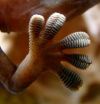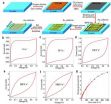(Press-News.org) WASHINGTON D.C. Aug. 12, 2014 -- If you've ever spent any time watching a gecko, you may have wondered about their uncanny ability to adhere to any surface -- including upside down on ceilings. It turns out the little lizards can turn the "stickiness" of toe hairs on the bottom of their feet on and off, which enables them to run at great speeds or even cling to ceilings without expending much energy.
In the Journal of Applied Physics, from AIP Publishing, Oregon State University (OSU) researchers describe their work exploring the subtleties of geckos' adhesion system mechanism.
"Since the time of the ancient Greeks, people have wondered how geckos are able to stick to walls -- even Archimedes is known to have pondered this problem," said Alex Greaney, co-author and an assistant professor of engineering at OSU. "It was only very recently, in 2000, that Kellar Autumn and colleagues proved unequivocally that geckos stick using van der Waals forces."
Van der Waals forces are weak atomistic level forces, "but geckos are able to take advantage of them because of a remarkable system of branched hairs called 'seta' on their toes," Greaney explained. "These seta and their hierarchy can deform to make intimate contact with even very rough surfaces -- resulting in millions of contact points that each are able to carry a small load."
Geckos -- as well as spiders and insects -- have independently evolved the same adhesion system mechanism and have been using it for millions of years.
"Understanding the subtleties of the process for switching stickiness on and off is groundbreaking," said Greaney. "By using mathematical modeling, we've found a simple, but ingenious, mechanism allows the gecko to switch back and forth between being sticky or not. Geckos' feet are by default nonsticky, and this stickiness is activated through application of a small shear force. Gecko adhesion can be thought of as the opposite of friction."
Greaney and colleagues also found that the entire process is quite subtle, so a synergistic combination of angle, flexibility, and extensibility of the hairs exists that results in incredibly robust and tough adhesion -- but still allow geckos to unstick without expending energy.
So, what kinds of applications will these findings enable? For the past 10 years, many researchers have been trying to create 'synthetic dry-adhesives' to replicate the gecko. In fact, these types of adhesives are already being used in climbing robots that can search through earthquake rubble in search of survivors.
One application of the team's work will be put to use improving these synthetic adhesives. "While we don't envision Mission Impossible sticky gloves, which are inspired by or based on the concept of gecko adhesion, we envision that robots will use gecko adhesion in extreme environments in the future," Greaney said.
What's next? "One of the really cool things that we've found is the way seta can absorb a large amount of energy, but also can recover it," Greaney said. "Absorbing energy makes for a tough adhesive joint -- for the gecko, it means it can catch itself after jumping or falling and also enables a gecko to rapidly dart off in different directions to avoid predation."
It's surprising that the easy detachment mechanism can recover this stored energy, so the researchers are interested in studying whether this is coupled with other aspects of the gecko's physiology to enable it to take advantage of the recovered energy -- much like a kangaroo does when bounding. "We're also interested in exploring how this robust, but switchable behavior, has the collective behavior of seta in a hierarchical system," Greaney added.
INFORMATION:
The article, "Role of seta angle and flexibility in the gecko adhesion mechanism," is authored by Congcong Hu and P. Alex Greaney. It will be published in the Journal of Applied Physics on August 12, 2014. After that date, the article can be accessed at: http://tinyurl.com/qabsfuz
ABOUT THE JOURNAL
Journal of Applied Physics is an influential international journal publishing significant new experimental and theoretical results of applied physics research. See: http://jap.aip.org
Geckos use toe hairs to turn stickiness on/off
The secret to geckos' amazing ability to adhere to ceilings and walls? A cool interplay of physics and, well, funky toe hairs on the bottom of their feet
2014-08-12
ELSE PRESS RELEASES FROM THIS DATE:
No excess baggage: Antarctic insect's genome, newly sequenced, is smallest to date
2014-08-12
COLUMBUS, Ohio – Scientists who sequenced the genome of the Antarctic midge suspect the genome's small size – the smallest in insects described to date – can probably be explained by the midge's adaptation to its extreme living environment.
The midge is a small, wingless fly that spends most of its two-year larval stage frozen in the Antarctic ice. Upon adulthood, the insects spend seven to 10 days mating and laying eggs, and then they die.
Its genome contains only 99 million base pairs of nucleotides, making it smaller than other tiny reported genomes for the body ...
Scientists discover the miracle of how geckos move, cling to ceilings
2014-08-12
CORVALLIS, Ore. – Researchers at Oregon State University have developed a model that explains how geckos, as well as spiders and some insects, can run up and down walls, cling to ceilings, and seemingly defy gravity with such effortless grace.
The solution, outlined today in the Journal of Applied Physics, is a remarkable mechanism in the toes of geckos that use tiny, branched hairs called "seta" that can instantly turn their stickiness on and off, and even "unstick" their feet without using any energy.
These extraordinary hairs contribute to the ability of geckos to ...
WSU researcher sees survival story in Antarctic fly's small genome
2014-08-12
PULLMAN, Wash.—Few animals can boast of being as tough as the Antarctic midge. Its larvae develop over not one but two Antarctic winters, losing nearly half their body mass each time. It endures high winds, salt, and intense ultraviolet radiation. As an adult, the midge gets by without wings and lives for only a week or so before starting its life cycle all over again.
And as Joanna Kelley has learned, it does this with the smallest insect genome sequenced so far.
"It's tiny," said Kelley, a Washington State University assistant professor, who recently sequenced and analyzed ...
Transgender relationships undermined by stigma
2014-08-12
PROVIDENCE, R.I. — Researchers who looked at the impact of discrimination, poverty and stigma on the mental health and relationship quality of transgender women and their male romantic partners found that social and economic marginalization not only takes a psychological toll on each person individually but also appears to undermine them as a couple.
It is difficult to be a transgender woman in the United States. Prior research has shown that they generally face high risks of depression, financial hardship, and discrimination, said study lead author Kristi Gamarel, a ...
Majority of Quebec children placed in out-of-home care are reunited with their family
2014-08-12
The majority of children in Quebec's youth protection system who are placed in out-of-home care (family foster care, or in a group or rehabilitation centre) are reunited with their "natural" families within 6 months, according to a study led by Professor Tonino Esposito of University of Montreal's School of Social Work. However, younger children, specifically those aged 2 to 5 years old at initial placement, have the lowest likelihood of returning to live with their natural families over time. "All placed children, irrespective of age, are less likely to return to live ...
Scared of crime? Good.
2014-08-12
EAST LANSING, Mich. -- In the past half-century, fear of crime in the United States has fueled "white flight" from big cities, become known as a quality of life issue and prompted scholars and law enforcement experts to address ways of reducing this fear.
But a study by a Michigan State University criminologist challenges this longstanding theory by arguing that a healthy fear of crime is, in fact, a good thing.
The study, published online in the journal Justice Quarterly, suggests adolescents who are more fearful of crime are less apt to become victims and offenders ...
ADHD, substance abuse and conduct disorder develop from the same neurocognitive deficits
2014-08-12
This news release is available in French. Researchers at the University of Montreal and CHU Sainte-Justine Research Centre have traced the origins of ADHD, substance abuse and conduct disorder, and found that they develop from the same neurocognitive deficits, which in turn explains why they often occur together. "Psychopathology exists on multiple continua of brain function. Some of these dimensions contribute to a multitude of problems, others contribute to specific problems. Together, they explain patterns of comorbidity such as why ADHD and conduct problems co-occur ...
Loss of eastern hemlock affects peak flows after extreme storm events
2014-08-12
The loss of eastern hemlock could affect water yield and storm flow from forest watersheds in the southern Appalachians, according to a new study by U.S. Forest Service scientists at the Coweeta Hydrologic Laboratory (Coweeta) located in Otto, North Carolina. The article was just published online in the journal Ecohydrology.
"Eastern hemlock trees have died throughout much of their range due to the hemlock woolly adelgid, an exotic invasive insect," said Steven Brantley, a post-doctoral researcher at Coweeta and lead author of the paper. "Though this insect has decimated ...
Graphene-based planar micro-supercapacitors for on-chip energy storage
2014-08-12
The rapid development of miniaturized portable electronic devices, such as micro-electromechanical systems, microrobots and implantable medical devices, has stimulated intense demand for micro-scale power sources. Although miniaturized micro-batteries that store energy by redox reactions provide the most frequently used micro-power source for current portable electronics on chip, their limited lifetime (hundreds or thousands of cycles) and low power density rule out applications that require high power over a short timeframe.
Micro-supercapacitors (MSCs) with a short ...
Researchers prove stability of wonder material silicene
2014-08-12
An international team of researchers has taken a significant step towards understanding the fundamental properties of the two-dimensional material silicene by showing that it can remain stable in the presence of oxygen.
In a study published today, 12 August, in IOP Publishing's journal 2D Materials, the researchers have shown that thick, multilayers of silicene can be isolated from its parent material silicon and remain intact when exposed to air for at least 24 hours.
It is the first time that such a feat has been achieved and will allow scientists to further probe ...
LAST 30 PRESS RELEASES:
Making lighter work of calculating fluid and heat flow
Normalizing blood sugar can halve heart attack risk
Lowering blood sugar cuts heart attack risk in people with prediabetes
Study links genetic variants to risk of blinding eye disease in premature infants
Non-opioid ‘pain sponge’ therapy halts cartilage degeneration and relieves chronic pain
AI can pick up cultural values by mimicking how kids learn
China’s ecological redlines offer fast track to 30 x 30 global conservation goal
Invisible indoor threats: emerging household contaminants and their growing risks to human health
Adding antibody treatment to chemo boosts outcomes for children with rare cancer
Germline pathogenic variants among women without a history of breast cancer
Tanning beds triple melanoma risk, potentially causing broad DNA damage
Unique bond identified as key to viral infection speed
Indoor tanning makes youthful skin much older on a genetic level
Mouse model sheds new light on the causes and potential solutions to human GI problems linked to muscular dystrophy
The Journal of Nuclear Medicine ahead-of-print tip sheet: December 12, 2025
Smarter tools for peering into the microscopic world
Applications open for funding to conduct research in the Kinsey Institute archives
Global measure underestimates the severity of food insecurity
Child survivors of critical illness are missing out on timely follow up care
Risk-based vs annual breast cancer screening / the WISDOM randomized clinical trial
University of Toronto launches Electric Vehicle Innovation Ontario to accelerate advanced EV technologies and build Canada’s innovation advantage
Early relapse predicts poor outcomes in aggressive blood cancer
American College of Lifestyle Medicine applauds two CMS models aligned with lifestyle medicine practice and reimbursement
Clinical trial finds cannabis use not a barrier to quitting nicotine vaping
Supplemental nutrition assistance program policies and food insecurity
Switching immune cells to “night mode” could limit damage after a heart attack, study suggests
URI-based Global RIghts Project report spotlights continued troubling trends in worldwide inhumane treatment
Neutrophils are less aggressive at night, explaining why nighttime heart attacks cause less damage than daytime events
Menopausal hormone therapy may not pose breast cancer risk for women with BRCA mutations
Mobile health tool may improve quality of life for adolescent and young adult breast cancer survivors
[Press-News.org] Geckos use toe hairs to turn stickiness on/offThe secret to geckos' amazing ability to adhere to ceilings and walls? A cool interplay of physics and, well, funky toe hairs on the bottom of their feet





